Rattle and hum: Live from broadcasting the Extreme E experience in Scotland
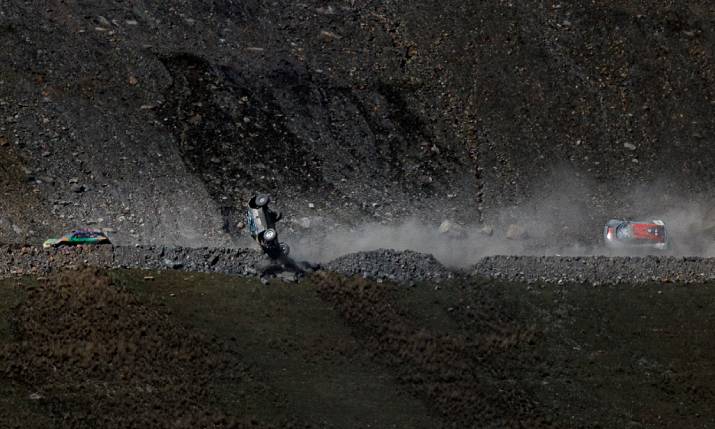
Aurora is capturing all the thrills and spills of Extreme E Hydro X Prix in Dumfries & Galloway, Scotland on 13 to 14 May 2023 [Credit: Michael Burns]
Set in a former open cast coalmine in Dumfries and Galloway, the hair-raising course dives down into a massive quarry, with plenty of clay on the ‘track’ to stick to the tyres. After recent heavy rain, as the course evolves and the clay is kicked up, the drivers must contend with ever-decreasing grip. A local farmer observing the race on TV later told me he wouldn’t even risk a tractor down the course due to the slippery nature of the ground.
Friday was a trial day but with just a single car testing out the course each time, the VIP Explorer lounge plays host to the rest of the 10 teams (equally split into male and female) of championship drivers. The team garages are alive with crews tweaking the Oddysey 21 electric cars, while in the TV compound host broadcaster Aurora preps for the weekend’s live broadcast. Inflatable tents make up both garages and TV compound, and it was in the latter that we caught up with Dave Adey, Extreme E’s head of broadcast and technology.
“The challenges here in Scotland are pretty similar to those we have most locations: power and internet, the building blocks of the championship,” says Adey. “In terms of power, we’re using a hydrogen fuel cell to generate the energy to charge the cars. For the rest of the paddock, the TV compound, and the team’s garages – anything apart from charging the cars – we use biofuel generators [running HVO (Enhanced Hydrotreated Vegetable Oil)] combined with big batteries. We also use solar power when we’re in countries that lend themselves to solar power.
“The challenge is to be self-sufficient with fuel,” he continues. “We’ve reduced our fuel consumption by about 75% in two years, and we aim to be carbon neutral in just over a season’s time. We partner with Power Logistics, which is always looking not just to provide the power but provide it in way that is sustainable and environmentally friendly, which is attuned with our championship. The ambition is that the hydrogen fuel cell will ultimately deliver power to the whole of the paddock. I think we’ll probably always tour with a couple of HVO generators for backup; let’s not forget we have a broadcast. We have no spectators on site and our messaging is through our TV product, so we need a very resilient power solution for our host broadcaster.
“Internet is always a challenge, but it’s probably less so here with a ‘home’ race,” he continues. “When we were in Chile, to get internet to where we were in the Atacama Desert, we had to have 75 kilometres of fibre to get from the nearest town.”
There’s fibre here too – though not quite 75 kilometres of it – installed to the cottage on the hillside below the Extreme E paddock.
Adey notes: “We microwave that up to the TV compound, where we plug it into our distribution system and provide quality of service,” says Adey. “Once we have the internet on site we can control it – the Media Centre will have more bandwidth than hospitality because journalists need to upload photos.”
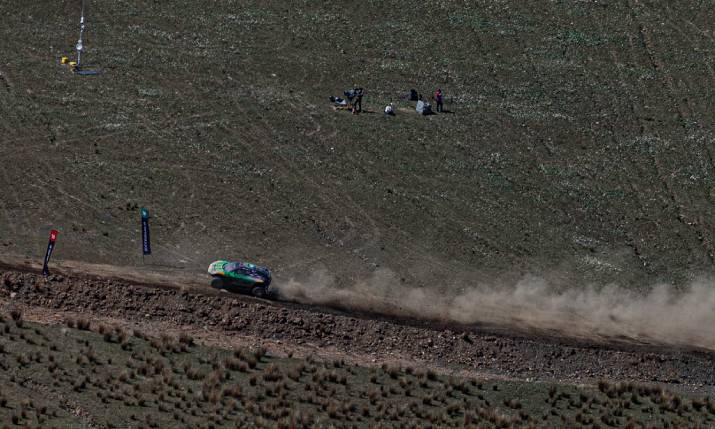
Each Extreme E Oddysey 21 race car has four onboard cameras, which makes for some exciting shots during the hectic race [Credit: Michael Burns]
Also needing connectivity are the multiple cameras that provide coverage of the race, of which there are around 70 in total.
“We have six cameras around the course with camera operators; they cover most of the action around the course,” says Adey. “Then we have 12 small ‘effects’ cameras, which we put in positions of jeopardy. That might be a waypoint, or it might be at a point where the director thinks there’s going to be some incidents with the car. But we can put those where we wouldn’t put any humans.”
Each Oddysey 21 has four onboard cameras, which makes for some exciting shots during the hectic race. “We usually have one of the onboards looking at the driver, another one looking forward, we might have a rear view, and another forward view. So that’s forty cameras in ten cars,” Adey calculates. “Then we have a couple of big drones, including a small first-person view (FPV) drone that will give us up close and personal action. We also have a couple of handheld cameras, where we have people wandering around the Switch zone area, and in the command centre.”
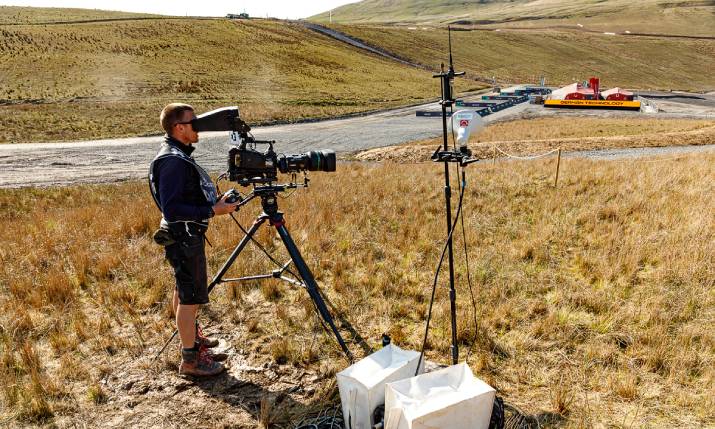
The camera feeds for Extreme E races come over wireless RF for the most part [Credit: Michael Burns]
Extreme E is also working on a proof of concept of a private 5G network in conjunction with Vodafone Business, which we’ll look at in depth in a subsequent article on SVG Europe. Such a move is par for the course with this organisation.
“Extreme E is always trying to be innovative, pushing the boundaries, and utilising new technologies. It’s not necessarily bleeding edge, because we need it to be working; with our TV product, we absolutely must get it right,” says Adey. “But the type of cameras we use, the position of the cameras, the drone footage, the onboard cameras, that all produces some very high-production value and exciting shots which is key to attracting the audience.”
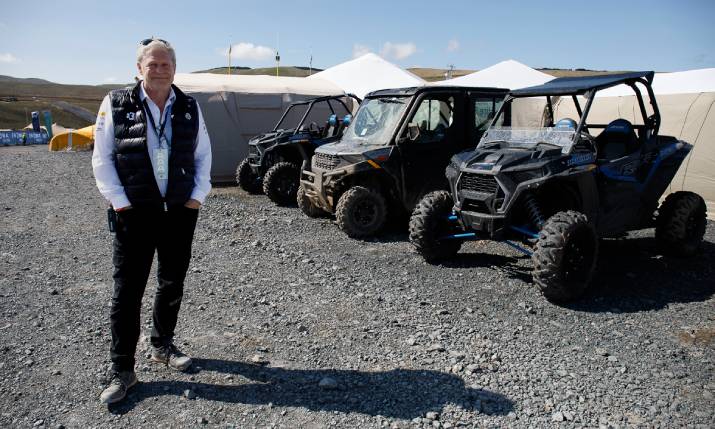
Dave Adey, Extreme E’s head of broadcast and technology [Credit: Michael Burns]
That’s vision, but what about sound? One of the things that’s different about this motorsport is the absence of the extraordinarily loud noise of racing cars. “One of the criticisms we’ve had, particularly from the diehard petrolheads, is that it doesn’t sound like a petrol engine,” says Adey.
“I know it doesn’t, it’s a different animal, it’s a different sport. When we first started the series and we heard the cars, we thought it sounded more like Star Wars pod racing, which is pretty futuristic. It’s difficult to describe, but you can sense the speed and the torque with the whirr of the electric motor. There’s no delay in the power distribution, you put your foot on the throttle, and the wheels spin.
“Also, you can hear other things going on; you can hear the rattle of the stones, and you can hear the bang when you have a crash. There’s a lot more you can appreciate than just the noise of an engine. All of our audio is done in 5.1 surround sound, so if you’re listening at home under those conditions, you hear this electric whirr, thumps and clattering of some stones coming around your head.”
Read more with Extreme E in Scotland: Battling the elements at Hydro X Prix here
It is not just the chance to bring out environmental effects for the benefit of the viewers; the camera crews and any site visitors do not have to wear ear protectors.
“We have schools coming to visit and we’re not worried about them deafening themselves with noise,” says Adey. “It’s also more in tune with the environmental narrative that we have. We go to remote, often very beautiful locations, whether it’s the Saudi desert or here in Scotland. You don’t want that beautiful scenery ruined by the noise of a petrol engine.”
Without fans on-site, the excitement of the race has to be conveyed in other ways.
“I think our camera shots do that, particularly the onboard ones where you’re at the front of the car, and you’re right up the backside of the car in front,” Adey says. “The commentators are fantastic at building up that enthusiasm, putting everything into context. A viewer new to the championship doesn’t necessarily have to have seen it before.
“It’s a very short race; you’re not in it for the long term,” he adds. “And that’s good for the generation we’re looking to attract, as they have a bit of a shorter attention span.”
“We’re also doing some social media pieces in the Explorer Lounge [we witnessed a tasting session of haggis bites and Irn Bru]. We’re a very inclusive championship,” He adds. “We want people to get involved, we want them to see behind the scenes, so we chat with the drivers in an informal environment.
Extreme E has a strong focus on a younger demographic. As part of the build-up, a group of 80 girls took part in a Girls on Track event.
“That younger generation is more attuned with the environmental messages that we are talking about,” says Adey. “They do listen, they do pick up on it, they are interested, and they are understanding it. That in conjunction with interspersing the race action with some of our legacy programme content that we’ve got, means you get more of the personal aspect of it. As well as the enthusiasm of the commentators, I think that adds to the excitement when you’re watching it on TV.”
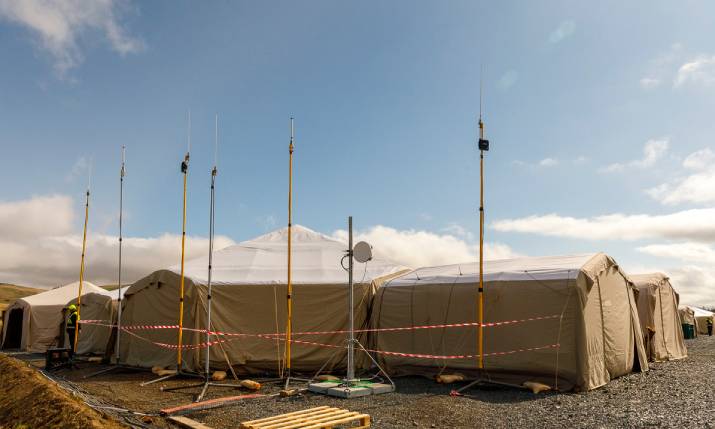
At the Aurora and Extreme E compound for the Hydro X Prix [Credit: Michael Burns]
The broadcast might also be called extreme remote production as the live programme is an amalgamation of content from four sites (see our previous story on the broadcast of the Hydro X Prix here).“Whenever you do an iteration, it’s either to simplify the operation, make it more cost-effective, give you added functionality and some added benefits, or de-risk it, ” says Adey. “We’ve sorted out any bugs and we’ve got a good robust solution. So we’re not trying to de-risk it further. We’re trying to get more bang for our buck.”
That means looking at if a specific camera can be used in several different locations. In the command centre, where the race officials and team members control and watch the race, we witnessed the use of a handheld camera mounted on a stabiliser harness, capturing the tension on the faces of the race teams when a car flipped off the track (the driver was fine). It’s also having the commentators, based in a London studio, interview a driver in the command centre, rather than bring an extra crew on-site. “That’s just a bit of smart working using the technology,” says Adey.
He adds: “It works well in a TV narrative. We have a huge amount of compelling content, and we can slice and dice appropriately for many different platforms to reach many different audiences,” he continues. “The skill involved is understanding what you have, understanding your market and what you must do to tap into that. And it’s all about growing the audience.
“This is not just motorsport; we class it as entertainment,” he concludes. “That along with the environmental and equality aspects, as well as electrification, are what we call our ‘four Es’.”
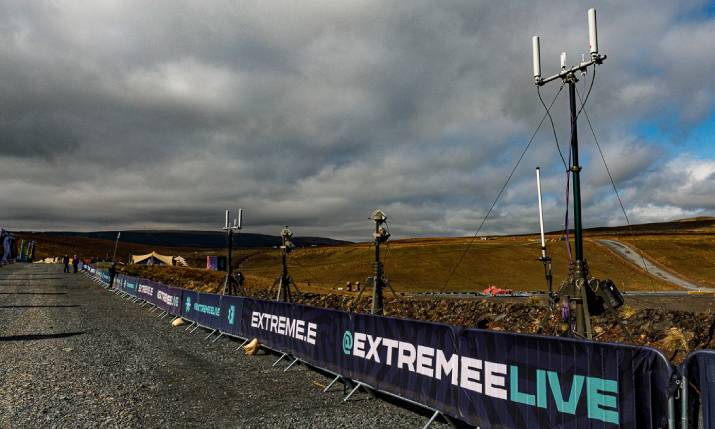
The Extreme E Hydro X Prix was held out in the wilds of Dumfries and Galloway in Scotland 13 to 14 May 2023
Read more Extreme E in Scotland: Battling the elements at Hydro X Prix
Read more PTO Tour Ibiza Part One: Broadcasting the Balearic triathlon with FilmNova
